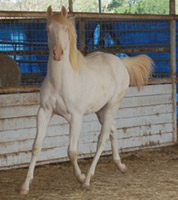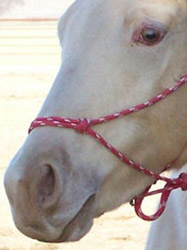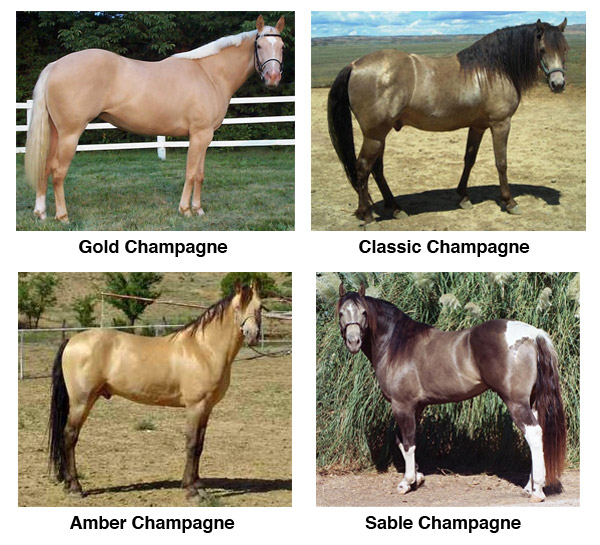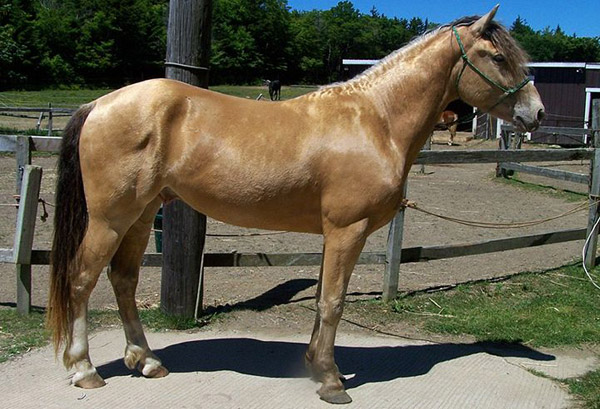
Image from Arrowmaker Ranch
In the last 20 years, DNA testing technology has become both equally complicated and commonplace.
Pair this ease of genetic testing with a rage for horses of exotic and unusual colors and the result has been previously unknown locations of the equine genome. One of these genes has been labeled the champagne gene due to its very unique phenotype (what the horse actually looks like).
Defining The Unknown
Champagne colored horses have no doubt existed prior to genetic testing, but were often registered as a more common color such as palomino simply because that was the closest known match. After seeing a champagne horse it is easy to understand the confusion. In an effort to more accurately trace the champagne gene, The International Champagne Horse Registry was created. This registry has mapped the likely history of the equine champagne gene in addition to documenting known champagne horses.
Champagne Breeds
Champagne is not found in every breed, but a few that are include: Tennessee Walking Horses, Missouri Fox Trotters, Kentucky Mountain Saddle Horses, Arabian crosses, American Saddlebreds, Quarter Horses, Welsh Pony crosses, American Cream Drafts and Miniature Horses. It seems, however, most prominent in the gaited breeds.
It should also be noted that champagne is a dominant gene so only one copy is necessary to have the full affect on the horse’s coat.
Champagne Characteristics
When looking at a champagne horse, the first thing usually noticed is that the horse’s coat has an incredible sheen to it. The champagne gene naturally puts a show sheen shine on the horse’s hair, more noticeable on the summer than winter coat. The gene also dilutes the horse’s base color to a whole rainbow of different shades. In each case, the coat color is lightened slightly with dramatic effect.

Image from Angie Marques
Those Eyes
Eye color is also affected by the gene. At birth, the eyes are blue but begin to change colors within a few weeks. Eye shades for the adult champagne horse are anywhere from green to a gold or amber color.
That Skin
Another characteristic of the champagne gene is a different pink hue to the horse’s skin. This is less noticeable on some horses and more on others. It is difficult to describe the difference in the pink skin of a paint horse and that of a champagne horse, but there is a notable difference in shade. The pinkish skin is most obvious on the muzzle, eye rims, sheath or udder and under the tail.
Also in these areas are freckles, another trait. Freckles are not uniquely characteristic of the champagne gene however they are almost always present in a champagne horse with few exceptions. Some combinations of dilute genes can produce a horse with few or no freckles.

The Colors
The base coat color of any horse determines the likely outcome a dilute gene will have on the horse’s color. For example, a sorrel or chestnut horse plus one cream gene will be a palomino whereas a bay with one cream gene is a buckskin. Likewise, champagne on a sorrel/chestnut horse is referred to as a gold champagne, on bay it is called amber champagne, champagne on a black horse as its base coat is a classic champagne.
The last color is called sable champagne. This color is based on an even newer gene annotated as Agoutit (At); phenotypically a “brown” horse. Test results on these horses will sometimes come back annotated with at least one “A” gene, though an actual agouti gene may not be present. A brown horse typically has little or no distinction between the body color and color of the points of the horse. If the horse is tested again for At and receives positive results as well as positive results for the champagne gene, it will be labeled as a sable champagne. Sable champagne shades will present with various shades of mocha colors.

Gene Combinations
Champagne is just another dilute gene among many like cream, dun, pearl, silver, etc. Many times champagne is inherited along with another of these dilute genes. These combinations produce double diluted horses and no two of the same gene couplings seem to the look alike. Many combinations have been documented by the ICHR such as champagne and dun.
Again though, the overall result for the horse’s color depends on the original base coat; so a grullo (black dun) champagne will look different than a red dun champagne even though both combinations of dilute genes are dun and champagne. Double dilutes including champagne can be silver, dun and pearl to name a few.
Another extremely small subset of champagne dilute combinations are triple dilutes. These horses have two genes in addition to champagne. Only 4 horses have been documented to have two cream genes with the champagne and only one with two cream genes, a champagne and a dun gene.
Conclusion
There are several animal genetics labs that test for the champagne gene including UC Davis and Animal Genetics Inc. All that is required is a sample of 30-40 mane or tail hairs with roots attached. Results come as quickly as an email a week after the sample is mailed. The exotic qualities of a champagne horse have it growing in popularity but large numbers of these horses can never depreciate the unique characteristics and ultimate sheen of a champagne colored horse.
Many Thanks
The world of color genetics is a difficult one to understand, so it is a fun treat to get help from someone who knows their stuff. Thanks to Karina for this thoughtful post, and for the images of her lovely perlino, champagne dun Morgan Dun N Stone. You can learn more about her & her horses on her website.
In your mention of the small subset of champagne dilute combinations, who is the, “…only one with two cream genes, a champagne and a dun gene”?
The only known is Morgan Dun N Stone, the horse in the picture at the top right corner of this article (more pics at the website). There is very likely another double cream, champagne, dun horse in existence but the closest I have been able to find in any registry or internet searching is a sable cream dun (1 cream) and a perlino champagne (no dun). The number of triple dilutes has, no doubt, increased since this article was published; however, it was true based on the ICHR’s site and registry at the time.
I have a 4yr old Red Dun Champagne. Her dam was registered gray her sire Red Dun Champagne. Her apperance took after her sire and I had waited for the dominate gray gene to exhibit but it never has. You can see the faded sorrel legs and dun markings and dorsal stripe down her back but she is very light. She is registered Red Dun but Champagne is noted in her comments.
Hello, US Davis has just confirmed our miniature colt has 1 copy of the Champagne gene, 2 copies of the silver gene and 1 copy of the creme gene. So he is a double dilute and is homozygous for silver. He looks just like a Perlino but with the champagne pink skin, small amount of mottling and his eyes are changing colour.
Has anyone else heard of this type of colouring ie the silver and cream over champagne? What did their horses look like? Thanks!